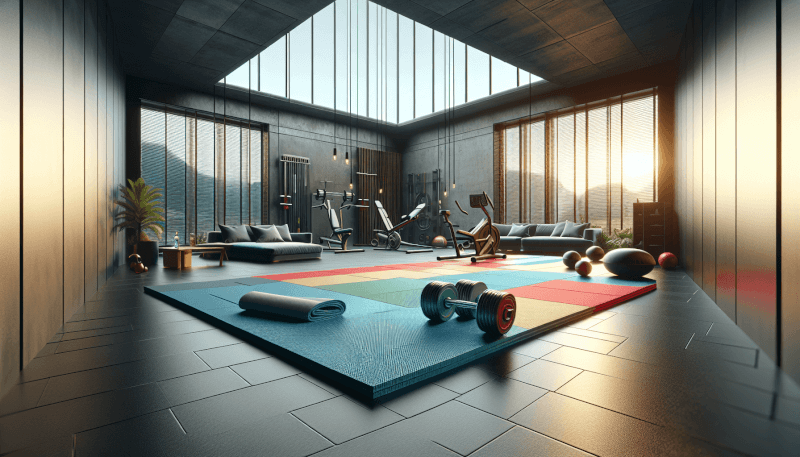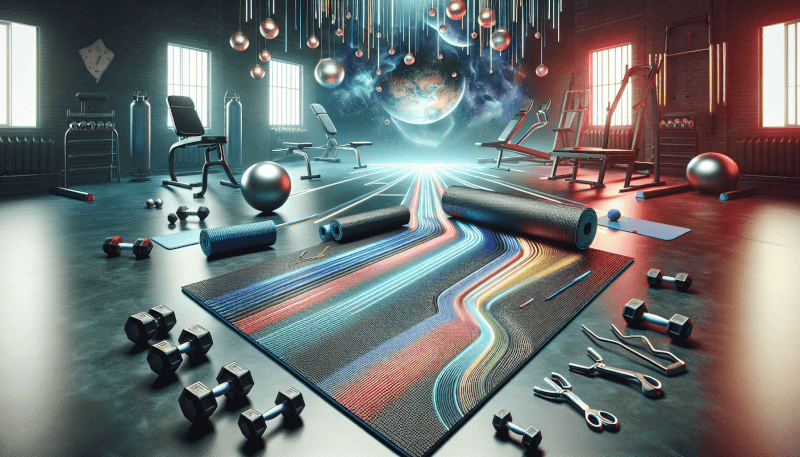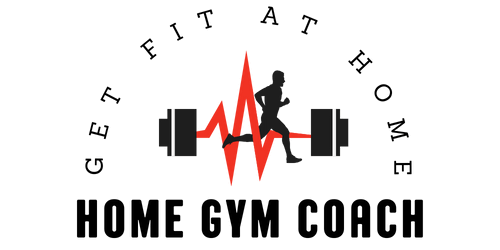Hey there, fitness enthusiast! Are you searching for the perfect addition to your home gym? Look no further than mats for your home gym! These versatile accessories not only provide a comfortable and safe surface for your workout routines but also protect your floors from scratches and damage. Whether you enjoy high-intensity workouts, yoga sessions, or weightlifting, investing in quality mats is essential for maximizing your performance and ensuring a pleasant exercise experience. So why wait? Upgrade your home gym with mats that cater to your specific needs and take your workouts to the next level!

Benefits of Using Mats for Home Gym
When it comes to setting up a home gym, one essential item that often goes overlooked is gym mats. Whether you have a dedicated workout space or are using a multipurpose room, investing in high-quality mats for your home gym can offer numerous benefits. Here are just a few reasons why incorporating mats into your home gym setup is a smart choice.
Prevents Damage to Floors
One of the primary benefits of using mats for your home gym is that they help protect your floors from damage. Heavy weights and exercise equipment can scratch, dent, or chip the flooring, especially if it’s made of hardwood, laminate, or tile. By placing mats underneath your equipment, you create a protective barrier that shields your floors from any potential harm, ensuring they stay in pristine condition for years to come.
Provides Comfort and Cushioning
Working out can be tough on your joints and muscles, especially during high-impact activities like jumping or weightlifting. This is where gym mats shine – they provide much-needed cushioning and shock absorption, reducing the strain on your body. You’ll be able to exercise for longer periods without discomfort, allowing you to push yourself further and achieve your fitness goals.
Reduces Noise and Vibration
Another advantage of incorporating mats into your home gym is that they help reduce noise and vibration. Dropping weights or using exercise machines can create loud noises that can disturb other members of your household or neighbors in close proximity. Mats absorb much of the impact and vibrations, minimizing the noise generated during your workouts. This not only creates a more peaceful environment for those around you but also helps maintain a positive relationship with your neighbors.
Enhances Safety and Prevents Injuries
Safety should always be a top priority when it comes to exercise. Using mats in your home gym significantly reduces the risk of injuries by providing a stable and non-slip surface for your workouts. The textured surface of the mats enhances grip, preventing accidental slips or falls that could lead to sprains or fractures. Additionally, the extra cushioning they offer reduces the impact on your joints and minimizes the likelihood of strains or other soft tissue injuries.
Types of Mats for Home Gym
When it comes to choosing mats for your home gym, you’ll be faced with several options. Each type of mat has its own unique features and benefits that cater to different exercise routines and preferences. Here are some of the most common types of mats you can consider for your home gym setup.
Rubber Mats
Rubber mats are one of the most popular choices for home gyms. They are known for their durability, shock absorption, and excellent grip. Rubber mats can withstand heavy equipment and intense workouts, making them ideal for weightlifting, cardio exercises, and high-intensity interval training (HIIT). Their non-slip surface provides secure footing, reducing the risk of accidents. Rubber mats also excel in noise reduction, making your workouts quieter.
Foam Mats
Foam mats are softer and more forgiving than rubber mats. They offer exceptional comfort and cushioning, making them perfect for low-impact exercises, yoga, Pilates, and stretching routines. Foam mats absorb shock effectively, protecting your joints from excessive pressure. They provide a stable and comfortable surface for floor exercises, allowing you to focus on proper form and technique. Foam mats are lightweight, easy to clean, and come in various thicknesses to suit your needs.
Interlocking Mats
Interlocking mats are versatile and customizable mats that offer a combination of cushioning and stability. They consist of individual tiles that interlock with each other, allowing you to create a seamless and secure floor surface in any shape or size. Interlocking mats are typically made of rubber or foam and can be used for a wide range of exercises, including weightlifting, floor workouts, and HIIT. They are easy to install, remove, and reconfigure, making them suitable for home gyms that require frequent changes or limited space.
Yoga Mats
Yoga mats are specifically designed for yoga practitioners but can also be used for other stretching and floor exercise routines. They are thinner compared to other gym mats, providing a firm and non-slip surface for yoga poses and movements. Yoga mats offer excellent grip, ensuring you can maintain balance and stability during challenging poses. They are lightweight, portable, and easy to clean, making them a convenient choice for both home and studio use.
Factors to Consider When Choosing Mats for Home Gym
With various types of mats available in the market, choosing the right one for your home gym can be overwhelming. To help you make an informed decision, here are several key factors to consider when selecting mats for your home gym.
Size and Thickness
Before purchasing any mats, it’s crucial to measure the available space in your home gym. Consider the dimensions of the area and any existing equipment or furniture that may limit the size or shape of the mats. Additionally, think about the thickness you require for your workouts. Thicker mats offer more cushioning and shock absorption, which is beneficial for high-impact exercises or those with joint issues, while thinner mats are suitable for activities that prioritize stability and balance.
Durability and Longevity
Investing in high-quality mats ensures their durability and longevity. Check the material used, such as rubber or foam, and opt for mats that are designed to withstand heavy use and intense workouts. Look for mats that are tear-resistant, non-slip, and have excellent resilience to prolonged pressure. Mats with good longevity save you money in the long run by eliminating the need for frequent replacements.
Ease of Cleaning
Maintaining hygiene in your home gym is essential to prevent the buildup of sweat, bacteria, and odors. Consider mats that are easy to clean and maintain. Some mats can be wiped down with a damp cloth, while others can be easily rolled up and stored away for cleaning. Choose mats that are resistant to moisture and allow for quick drying to minimize the risk of mold or mildew.
Slip-Resistance
To ensure a safe and stable workout environment, opt for mats that offer slip-resistant surfaces. Look for mats with textured or embossed patterns that provide reliable grip, even when you’re sweating. This feature is especially crucial for exercises that involve quick movements, lateral shuffling, or balance poses. Slip-resistant mats help prevent accidental slips, falls, or injuries during your workouts.
Cost
Consider your budget when choosing mats for your home gym. While it’s essential to invest in durable and high-quality mats, that doesn’t mean you have to go overboard with your spending. Compare different options and prices available in the market, taking into account the features and benefits offered by each type of mat. Remember, finding the right mat that suits your needs and requirements is the ultimate priority.
Tips for Maintaining Mats for Home Gym
Taking proper care of your mats is crucial to keep them in good condition and prolong their lifespan. Here are a few simple tips to help you maintain your mats for your home gym:
Regular Cleaning
Regularly clean your mats to remove dust, dirt, and sweat buildup. Use a mild soap or mat cleaner and wipe down the surface with a soft cloth or sponge. Avoid using harsh or abrasive cleaners that can damage the material. If your mats are machine-washable, follow the manufacturer’s instructions for proper cleaning.
Usage of Disinfectants
To prevent the growth of bacteria or viruses, consider using a disinfectant spray or solution on your mats after each workout. Look for disinfectants specifically formulated for gym equipment and mats, and follow the instructions carefully. Allow the mats to air dry completely before using them again.
Proper Storage
When not in use, store your mats in a clean and dry area. Avoid exposing them to direct sunlight or extreme temperatures, as these conditions can cause the material to deteriorate. Roll up or fold the mats neatly to prevent creasing or bending.
Inspection for Wear and Tear
Regularly inspect your mats for any signs of wear and tear. Pay attention to any holes, tears, or frayed edges. Replace damaged mats promptly to avoid any safety hazards during your workouts.

How to Choose the Right Size and Thickness of Mats for Home Gym
Choosing the right size and thickness of mats for your home gym is essential for a comfortable and effective workout experience. Here are some considerations to help you make the right decision:
Consider the Available Space
Begin by measuring the available space in your home gym. Take into account any existing equipment and furniture to determine how much floor area you have for the mats. This will help you choose the appropriate dimensions and shape of the mats that fit your space perfectly.
Determine the Types of Exercises
Consider the types of exercises you’ll be performing in your home gym. If your workouts involve high-impact activities like weightlifting or cardio exercises, opt for thicker mats that provide ample cushioning and shock absorption. For low-impact exercises or activities that require stability and balance, thinner mats may be more suitable.
Account for Extra Equipment
Take into consideration any additional equipment you’ll be using in your home gym. If you have heavyweights, treadmills, or exercise machines, ensure that your mats are large and thick enough to accommodate these items without compromising safety or functionality.
Choose the Appropriate Thickness
The thickness of your mats plays a significant role in providing comfort and protection for your joints and muscles during workouts. Generally, thicker mats, such as those ranging from 1/2 inch to 3/4 inch, are ideal for high-impact activities. Thinner mats, around 1/4 inch, are suitable for low-impact exercises or activities that require stability and balance.
Comparing Rubber Mats, Foam Mats, Interlocking Mats, and Yoga Mats
To help you determine the right type of mat for your home gym, here’s an overview of the features and benefits of rubber mats, foam mats, interlocking mats, and yoga mats:
Rubber Mats: Features and Benefits
- Durability: Rubber mats are highly durable and resistant to heavy use and impact.
- Shock Absorption: They offer excellent shock absorption, making them ideal for weightlifting and high-intensity exercises.
- Grip and Stability: Rubber mats provide a non-slip surface, ensuring stability and grip during workouts.
- Noise Reduction: Their dense material reduces noise and vibrations caused by dropping weights or exercise machines.
- Easy Installation: Rubber mats are easy to install and require minimal maintenance.
Foam Mats: Features and Benefits
- Comfort and Cushioning: Foam mats offer exceptional comfort and cushioning, reducing strain on joints and muscles.
- Versatility: They are suitable for low-impact exercises, yoga, Pilates, and stretching routines.
- Shock Absorption: Foam mats effectively absorb shock, protecting your joints from excessive pressure.
- Lightweight and Portable: Foam mats are lightweight and easy to move, allowing for flexible use and storage.
- Easy Maintenance: They are easy to clean and come in various thicknesses to cater to your specific needs.
Interlocking Mats: Features and Benefits
- Customizable Configuration: Interlocking mats consist of individual tiles that can be arranged to fit any space or shape.
- Versatility: They can be used for various exercises, including weightlifting, floor workouts, and high-intensity training.
- Cushioning and Stability: Interlocking mats provide cushioning for comfort and stability during workouts.
- Easy Installation: They are quick and easy to install, remove, and reconfigure, allowing for convenient customization.
- Durability: Interlocking mats are made of durable materials, ensuring long-lasting performance.
Yoga Mats: Features and Benefits
- Grip and Stability: Yoga mats provide a firm and non-slip surface, ensuring grip and stability during yoga poses.
- Comfort and Balance: They offer a comfortable surface for floor exercises and help maintain balance.
- Portable and Lightweight: Yoga mats are lightweight and easy to roll up, making them portable and convenient for travel.
- Eco-Friendly: Many yoga mats are made from natural or recyclable materials, promoting sustainability.
- Easy to Clean: They are easy to clean, and some can be machine-washed for hassle-free maintenance.
Factors to Consider When Choosing Rubber Mats
If you’ve determined that rubber mats are the right choice for your home gym, here are some key factors to consider when making your selection:
Material Quality
Invest in rubber mats made from high-quality materials to ensure long-lasting durability. Look for mats made from natural or synthetic rubber, as they offer excellent resistance to wear and tear.
Thickness and Density
Consider the thickness and density of the rubber mats. Thicker mats provide more cushioning and shock absorption, while denser mats offer better stability and durability. Choose a thickness that suits the intensity of your workouts and the needs of your joints.
Shock Absorption
Rubber mats are known for their excellent shock absorption properties. Check the mat’s specifications for its shock absorption rating, which indicates how well it can absorb impact and protect your joints.
Stability and Grip
Ensure that the rubber mats offer a stable and non-slip surface. Look for mats with textured patterns or grooves that enhance grip and prevent accidental slips or falls.
Ease of Installation
Consider the ease of installation of the rubber mats. Some mats come in interlocking tile forms, while others are rolled sheets. Choose the type of mat that suits your preference and the layout of your home gym.
Factors to Consider When Choosing Foam Mats
If foam mats are a better fit for your workout needs, here are some important factors to consider when selecting:
Material Quality
Opt for foam mats made from high-quality materials to ensure longevity and durability. Look for mats that are resistant to tearing, easy to clean, and retain their shape over time.
Thickness and Density
Consider the thickness and density of the foam mats. Thicker mats provide more comfort and cushioning, while denser mats offer better support and stability. Choose a thickness and density that offers the right balance for your exercises.
Shock Absorption
Foam mats should have excellent shock absorption properties to protect your joints and muscles during exercises. Look for mats that state their shock-absorbing capabilities to ensure optimal comfort and safety.
Versatility
If you plan to engage in various low-impact exercises, ensure that the foam mats are versatile enough to accommodate your workout routine. Look for mats that offer stability and grip, regardless of the exercise you’re performing.
Ease of Installation
Consider the ease of installation and maintenance for foam mats. Opt for mats that are lightweight, easy to roll up or store, and allow for quick cleaning. Mats with interlocking edges or puzzle-like designs are user-friendly and offer customization options.
Factors to Consider When Choosing Interlocking Mats
If interlocking mats are more suited to your home gym setup, here are some factors to consider:
Material Quality
Select interlocking mats made from high-quality materials that are resistant to wear and tear. Look for mats made from durable rubber or foam to ensure performance and longevity.
Thickness and Durability
Consider the thickness and durability of the interlocking mats. Thicker mats provide better cushioning and support, while durable mats withstand intense workouts and heavy equipment.
Impact Absorption
Interlocking mats should have excellent impact absorption capabilities to protect your joints and reduce noise. Look for mats that offer superior shock absorption, minimizing stress on your body.
Ease of Installation and Customization
Choose interlocking mats that are easy to install and allow for customization. Mats with puzzle-like edges or interlocking mechanisms are simple to assemble, remove, and rearrange to fit your desired layout.
Factors to Consider When Choosing Yoga Mats
If you’re specifically looking for yoga mats, here are some factors to consider when making your selection:
Material Quality
Opt for yoga mats made from high-quality materials that are durable and provide the necessary cushioning. Look for mats made from natural rubber or PVC, as they offer excellent grip and durability.
Thickness and Grip
Consider the thickness of the yoga mats. Thicker mats provide more cushioning, making them comfortable for floor exercises and yoga poses. Ensure that the mats offer a non-slip surface with good grip to prevent accidental slips or sliding.
Eco-Friendliness
If sustainability is important to you, choose yoga mats that are environmentally friendly. Look for mats made from natural or recyclable materials that minimize their impact on the environment.
Portability and Storage
Consider the portability and storage options for yoga mats. Lightweight and easily foldable mats are convenient for those who are constantly on the go or prefer practicing yoga outside of their home gym. Look for mats that come with carrying straps or bags for easy transportation.
By considering these factors and understanding the features and benefits of different types of mats, you can make an informed decision that complements your home gym setup and workout routines. Investing in the right mats not only enhances your fitness experience but also contributes to a safe and comfortable workout environment. So go ahead and choose the mats that best suit your needs, and enjoy your home gym to the fullest!


